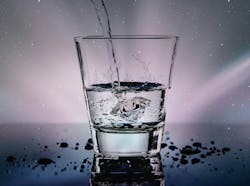Ozone Sanitization of Purified Water Loops
Chris Rombach is president of Pacific Ozone Technology. Rombach can be reached at [email protected] or at 707.747.9600.
Virtually every company that makes products where one of the ingredients is water has installed elaborate water treatment systems to purify the water provided from their local municipality. One “impurity” that is removed is the residual chlorine. Once removed, the water no longer has residual disinfection powers. This high-purity water is often stored and recirculated in process loops that provide the water to a variety of points of use.
Keeping tank and piping systems free of biofilms and other microbial contamination can become a challenge. The key is regular sanitization of the water distribution to maintain acceptable microbial limits. Sanitization Requirements
While other process/product lines may be connected to a multi-step clean-in-place system, purified water loops typically are not. Companies perform the sanitizations internally or hire water treatment companies to sanitize the equipment in the loop. Typically, chlorine-based oxidants or acids are utilized. This can be time consuming, expensive and does not always provide the desired results, leading to more frequent sanitizing and higher concentrations used. If unsuccessful, product contaminations are likely. If persistent biofilms are allowed to flourish, removal can become nearly impossible. Ultraviolet (UV) disinfection systems are often installed, which cannot protect against bacterial ingress that may occur downstream.
Portable or Integrated
Ozone’s efficacy versus yeasts, molds, bacteria, viruses and biofilms is well documented. It is easily generated on site, highly effective and leaves no disinfection byproducts.
Several approaches can be utilized. Portable ozone systems are brought to facilities, connected to the water loop and ozonate the water recirculating through the system.
Integrated ozone systems can be installed permanently as a method of maintaining low levels of ozone in the water in the storage tank and subsequently having the capability to elevate levels to disinfect the entire purified water loop. An integrated system can be installed to provide ozone-enriched water to the storage tank via a small side stream recirculation loop. Ozone monitors are placed at the outlet of the storage tank, post-UV and then at the end of the return loop. During sanitization, the ozone dose and the residual at the return of the loop are critical measurement points. Before production resumes, the UV light must be restarted and once the ozone monitor shows the complete lack of ozone in the water, manufacturing can begin again.
Ozone-based sanitization can be carried out weekly, monthly or quarterly. Systems can be manual or fully automated and integrated into the plant’s water process system. Such systems can be programmed to run during non-production time and can be quickly brought back on line with little interruption to weekly outputs.
Ozone Advantages
- FDA-listed as organic and acceptable for direct food contact;
- No disinfection byproducts;
- No required flushing of the system;
- No chemicals are added to the facility’s waste stream;
- No chemical transportation/storage;
- Quicker: typical sanitization cycles are reduced by 30% to 75%;
- Ozone can be turned off instantaneously by UV at 254 nm; and
- Heat is not required.
System Considerations
Compatibility of in-line equipment must be confirmed versus the expected doses of ozone. As ozone decays rapidly in the presence of heat, ambient water temperatures above 80°F are problematic. The overall ozone loop length must be determined due to the inevitable decay of ozonated water pumped from point to point. Lines greater than 350 ft may require additional ozone at the inlet.
Proper integration of the ozone system into the company’s existing process is essential. Coordination between the production, engineering and quality departments must meet the needs of individual stakeholders. Through careful planning, ozone can increase line utilization, improve overall product quality by minimizing or eliminating contaminations in the factory water supply and help manufacturers meet regulatory and product safety requirements.
While many companies have UV systems already installed inline, the company must confirm that the unit is operating at 254 nm, the most effective UV wavelength for ozone destruction. The sizing of the UV must be confirmed by the manufacturer to assure the destruction of ozone can be accomplished at the designed flow rate.
Realizing Benefits
Ozone is increasingly being used to sanitize purified water loops at production facilities. Reductions in chemical expenditures, water usage, lost production time and sanitization time can be realized with the adoption of ozone for purified water loop sanitization. Implemented correctly, ozone can be a natural alternative to harsh chemicals.
Download: Here
